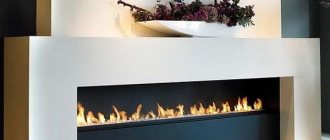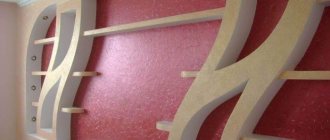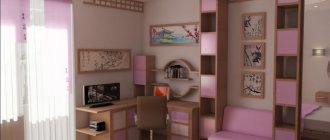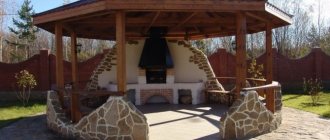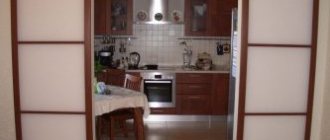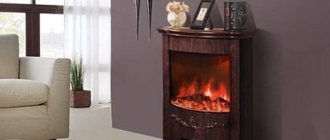We work independently
As a rule, standard fireplaces are heated with wood. This means that the smoke that is produced as a result of their combustion has to go somewhere. It is easier to install a pipe system in a private house, but in an apartment it is a little more difficult. In order to competently carry out this stage of work, it is recommended to hire a specialist. The very façade of a fireplace in a room is very easy to make, and for this we will need the following materials: metal corners, bolts and natural stone. If you are building false fireplaces or are planning to install an electric model, then you can use drywall. Before you start building a corner fireplace in the living room interior with your own hands, decide on the dimensions. The design should not take up much space, but at the same time its parameters should be sufficient for the fireplace to provide heating for the entire room.
Fireplace design
A decorative or false fireplace, which is assembled from plasterboard, is a metal frame covered with material. Instead of drywall, you can use other finishing materials. But thanks to plasterboard sheets, you can give the fireplace curved and smooth shapes, fitting it perfectly into the interior of your home. A corner false fireplace, as the name suggests, is placed in the corner. As a result, its device rests on two interlocking walls and the floor. This is precisely the peculiarity of this version of a decorative fireplace, when assembling it with your own hands. According to its design features, the corner fireplace has the following components:
- base;
- a niche for placing a device simulating an open fire;
- a portal that represents the external design of the fireplace.
Fireplace with shelf
Sometimes, some people, to create a greater resemblance to a real fireplace, make a pipe at the top of the structure. But this is not very functional, since apart from the external similarity, this pipe does not carry any more load.
A corner fireplace, which is assembled with your own hands and covered with plasterboard, often has a shelf in its upper part. Thanks to it, various decorative items can be placed on top of the fireplace, which will give the design more originality and sophistication. In addition, such a decorative fireplace has a number of advantages compared to other options. The advantages of this device are as follows:
- saving space in the room;
- there is almost always a free corner in the room in which this device can be placed;
- due to the angular placement, you can slightly increase the size of the portal, which will make such a fireplace larger;
- ideal fit into any interior;
- This placement does not interfere with free movement around the room.
It is worth noting that a corner fireplace will always look more authentic than other assembly options. This design will be an ideal solution for an apartment where installing a real fireplace is simply unrealistic.
A couple of location tips
If you want a fireplace in your home to perform a heating function, do not place it on an outside wall or at a junction where one of the walls faces the street. In this case, it will heat the outside of the house, not the inside. Yes, no doubt: a corner fireplace in the living room interior between the windows looks quite interesting. Photos of such solutions, which, by the way, are replete with the pages of many glossy magazines, are further confirmation of this. However, this is just beautiful, but absolutely not practical. It’s another matter if you are installing a false fireplace, or the structure will be electric, and its main function is decoration, not heating. It is also recommended to hang a TV on the wall, which is perpendicular to the one under which our “hearth” is located. This will create a cozy corner that will be set aside specifically for relaxation. It can be surrounded by sofas, armchairs and rocking chairs.
Sheathing the frame
After assembling the frame, the entire structure should be sheathed with material. It is better to use fire-resistant plasterboard sheets, especially if you will be placing lit candles inside the fireplace. But in this situation, you can also use standard sheets. They will cost slightly less than fire-resistant material, but they do not have fire-resistant properties. Therefore, their use may create a fire hazard. The peculiarity of covering a corner false fireplace with plasterboard sheets with your own hands is as follows:
- the need to cut the material into small pieces to sheathe the base and interior of the portal;
- here you will have to use much more perforated corners than with other design options. Only with them will you achieve perfectly even internal and right angles.
Sheathing
In all other respects, installation of plasterboard sheets is carried out according to the standard scheme. The main thing here is to observe all the corners so that when finishing they do not lead to the appearance of cracks and falling off of the decorative finish. As you can see, assembling a decorative corner fireplace made of plasterboard is not particularly difficult. Follow the instructions above and you will have an excellent fireplace that will be as close to the real thing as possible.
Rack profiles for plasterboard structures: what they are, scope of application
Options for beautiful plasterboard ceilings for the hallway
Advantages that a corner fireplace can boast of
A living room with a corner fireplace is not only a very stylish solution, but also very comfortable. Firstly, by installing such a massive structure in the corner, we save space. Secondly, a fireplace that is located immediately under two walls (if neither of them is external, see above) heats more rooms. His warmth reaches those rooms in which he himself is not located. And thirdly, this option provides wide scope for the most daring design solutions. A cozy corner can be decorated both in a classic style and in the spirit of modernity. A living room with a corner fireplace, the interior of which will imitate a spaceship or a Japanese apartment (there may be many more options), will look very unusual and attractive.
Brick fireplaces
This material is an undeniable classic. If the corner fireplace in the living room interior is made from it, then comfort, enormous heat transfer and an incomparable fairy-tale atmosphere in the house are guaranteed. The use of brick opens up huge creative spaces for designers. Here a variant of the standard classics is possible (solid furniture, parquet and woolen carpets). If you decorate the façade of the fireplace to look like stone, you will get the perfect rural house. The living room can be complemented with rattan furniture, raw wooden beams, folk ornaments and embroidered napkins. A brick corner fireplace in the living room interior can also serve as additional storage for accessories and books. There may be shelves or even drawers above it. Another original option is a brick fireplace, which will be “lost” against the background of the same brick walls, painted in the same color. A non-standard solution, ideal for loft style.
Rules for installing a corner fireplace
Having shed some light on the nuances of the shapes of a corner fireplace and their role in the overall interior of your home, let's look at a few fundamental rules for its installation.
- It is advisable to install the fireplace in the center of the house, since this is where the chimney will be closest to the ridge of the building;
- The height of the chimney is also calculated based on the proximity of the location to the ridge. So, if the chimney is located at a distance of up to 1.5 m from the ridge, then its height should be half a meter higher than the ridge. If at a distance of up to 3 m, then almost level, and if over 3 m, then it is necessary to set aside a 10-degree angle from the horizon line;
- You can place such a fireplace against any wall, you just need to take care of installing the chimney;
- If you've recently purchased a home and don't know exactly what the interior walls are made of, be sure to check the architectural plan. For example, it is contraindicated to place fireplaces next to adobe walls, since exposure to high temperatures may smolder this material, even without access to oxygen;
- The back wall of the corner fireplace should be slightly tilted forward. This improves its heat-reflecting characteristics;
Either way, modern corner fireplaces are a great way to add some flair to your home and keep you warm on a winter evening!
Construction and installation of a fireplace
Metal furnaces
A heat source built from metal is considered by many to be far from the best design solution for their home. But, as practice shows, it is completely in vain! In fact, it is the metal corner fireplace in the living room interior that looks stylish, unusual and very original. The photos also clearly show us that such structures are very compact, and therefore suitable for apartments where, alas, there are few square meters. A stove made of iron opens up enormous scope for creativity. It can be “walled up” in the wall, leaving only the firebox visible where the flame will burn. This option is ideal for an interior in a minimalist or high-tech style. The metal frame can be finished with decorative stone, recreating the previous “brick” project. Metal fireplaces can take any shape - triangle, square, circle, ellipse, etc., they can be suspended or located in a niche, deep between the walls.
Pros and cons of such an invention
The electric fireplace became a significant breakthrough in the art of design, making it possible to add zest to the interior of urban homes. Like any device, an electric fireplace has certain advantages and disadvantages. The advantages are:
- the unit does not require fuel (since the fireplace is powered from the mains, there will be no burning smell in the room);
- simple installation (no chimney or foundation required, so you save on the services of a master mason);
- high-quality heating of the living room (two kilowatts of power is enough to heat an area of 24 square meters);
- reasonable price (the devices are much cheaper than their wood-burning counterparts);
- high level of fire safety (electric fireplaces are no more dangerous than other appliances in your home);
- autonomous mode (the fireplace can be set to heat the room, or it can be switched to a purely “decorative” mode);
- ease of transportation (the dimensions of electric fireplaces are small, so they can be brought to the dacha and then taken back).
If everything is so good, why do some homeowners abandon the idea of an electric fireplace in favor of a more traditional wood-burning hearth? There are only three disadvantages of an electric fireplace:
- fan noise (the operating principle of the device resembles a fan heater - air is forced through heating coils);
- high energy consumption (if you switch the fireplace to heating mode and turn on a bunch of additional appliances, the wiring may not be able to handle it);
- artificiality of the flame (the pattern of flames is repeated with a given cyclicity, so that you are constantly aware that this is a fake).
When choosing an electric fireplace, we recommend using the tips from the following video:
False structures to create coziness
In order to make your home more stylish and warm, it turns out that it is not at all necessary to install a real stone corner fireplace in the living room. Photos of many projects that we see in magazines and on portals of relevant topics show us that it is possible to mount an electric or gas fireplace that will look like the real thing, and maybe even better. The fact is that such fireplaces are much easier to install, they operate using gas or electricity rather than wood, do not require an overly complex exhaust system and do not take up much free space. The only thing is that gas structures must always be connected to the gas supply system. These could be pipes or an additional cylinder. By constantly filling it, you will have an eternally burning fireplace in your home.
All the beauty of electrics
An electric corner fireplace in the living room interior is a real godsend for apartments. This design will take up no more than 30 centimeters of free space, and you will have an excellent cozy corner that will look realistic and create the illusion of being in a distant, quiet village. Today such products are offered by ordinary construction stores. The base of the fireplace, its firebox and all other connecting elements can be easily found on one of the counters or ordered from a catalog. Such fireplaces can be finished with decorative stone, chromed steel, or simply painted in any color you need. Thanks to this versatility, the electric fireplace easily fits into any interior. With its help, a designer can create both a fabulous cozy house and a noisy living room in a high-tech style, which will be full of interesting accessories and unusual furniture.
Technology and preparation
Before you begin the process of building a fireplace, you need to draw up a masonry diagram that you will follow. For greater convenience, you need to have appropriate order drawings for this scheme. You can consider this a must for yourself if you are a beginner.
Ordering and schemes
When calculating the size of the fireplace, you need to pay attention to the size of the room: its area and volume. We will consider a fireplace with a firebox volume of 0.25-0.3 cubic meters. m.
In order to prepare everything and draw up an approximate project of how to lay out a fireplace with your own hands, you need:
Appearance and section of a corner fireplace.
- Determine the width and height of the fireplace insert opening. It is also called the firebox portal. Accordingly, it is necessary to ensure that the proportions are 3:2. For small fireplaces, this is the typical ratio of the height of the fireplace to its width. We will take 60X40 as an example.
- It is necessary to determine the depth of the firebox. It must be correlated with the height of the firebox opening. The norm is usually a ratio of 2:1 or 3:2. If you select a greater depth, the heater will have less heat transfer. But a depth with a smaller size can cause completely unnecessary smoke in the room, while still having quite good draft. In this case, a depth of 22-30 cm can be attributed.
- To remove smoke, different holes are selected. They need to be selected, also based on the dimensions of the firebox slot. It is best to make the combustion part about 9-15 times larger than the smoke hole.
- If you want to improve heat transfer properties, you can slightly tilt the wall of the firebox forward. A smoke vent is installed above the firebox itself, that is, in its upper part. But a cornice is installed between the smoke outlet and the wall, which will not allow smoke to enter the room and will not allow sparks to escape through the pipe.
- Do-it-yourself corner and wall fireplaces usually begin with laying the first - initial - rows of bricks. There are special bricks for laying fireplaces. They have standard dimensions: 25x12x6.5 cm. The seam size is approximately 0.5 cm.
- The remaining dimensions of the brick fireplace are adjusted in accordance with the cross-section of the firebox level. After the masonry with your own hands is completed to this level, you need to draw a plan: ordering, layer-by-layer masonry.
Material selection
Now we begin to prepare the material that we will use in the future and determine its quantity. To lay a corner fireplace with your own hands we will need:
Crushed stone will be needed to construct the foundation.
- Bricks. They must be counted individually. And every half or even quarter should be counted as a whole brick. It is very important to ensure that the brick is strong, without voids inside, so that there is no underburning or overburning. If you have bricks left after you dismantled your old fireplace, they can also be used, but only if they are intact: no cracks, not broken. Bricklaying is a fascinating process.
- Sand. Coarse-grained sand, the fraction of which is from 0.3 to 1.5 mm, is best suited. This sand needs to be sifted to remove various debris, dust, etc.
- Clay. It may be necessary to use clay, it is best to choose the Cambrian variety dry or in clumps.
- Cement. It must be purchased packaged. There is no point in using brands higher than M500, so choose smaller brands.
- Crushed stone. It will be needed in order to build a foundation; the fraction should be from 2 to 6 cm.
Features of the order
There are some tricks to help you get a result that will please the eye.
Before you start laying the fireplace, you need to decide how the order will be done.
To do this, you can make schematic images. This way, you won’t get confused during the laying process and will clearly know what you are doing and what your next step will be.
If you want a brick fireplace to look more or less original, you can install a plinth by placing each brick on its edge. The base of the firebox should be above the floor level, approximately 25-30 cm in height (this is after the 3rd row).
To help your fireplace heat the room better, you can install reflective insulation between the wall of the house and the wall of the fireplace.
Basic moments
The size of the foundation itself should be suitable for a brick fireplace. For various stoves, fireplaces, barbecues and other structures, even if there is a fairly strong and good foundation, you need to build an additional foundation.
Laying a fireplace with your own hands begins with waterproofing, and a two-layer one. Materials that will be needed for this: roofing felt or roofing felt.
What to do with clay? It needs to be soaked approximately 3 days before starting work. It is better to add water to clay solutions little by little, while thoroughly stirring the solution.
Another brilliant solution for an apartment
It is known that installing exhaust systems, additional pipes, as well as the stone fireplace itself in a modern apartment will cause a lot of trouble for the owner. Therefore, modern masters have created a unique creation - a bio-fireplace, which does not require the presence of this entire exhaust system. And the flame is maintained in the firebox in the following way: the combustion product is ethyl alcohol. When it burns, it does not emit harmful volatile substances, does not generate soot or soot, and does not even create smoke around itself. This environmentally friendly heating system also takes up very little space. Even if you install a bio-fireplace just under one of the walls, it will take up no more than 30 centimeters of room space. Well, if you choose a corner model, which is much more profitable and economical, you will not notice at all that the room has become a little smaller.
Types of biofireplaces
An environmentally friendly corner fireplace in the living room can be made in any style. In fact, it can be considered an analogue of an electric one; they differ from each other only in the principle of operation. Therefore, you can order a bio-fireplace finished with artificial stone, and thus equip the room in a classic or antique style. If the fireplace is made of thermal glass, it will fit perfectly into a modern interior. Such designs are an excellent element of decor in rooms made in the Japanese style, in the minimalist style and harmonize well with other varieties of modern design fantasies. A bio-fireplace will look great in a loft interior. Located in a corner, such a small fireplace will create an aura of comfort among rough brick walls, old furniture and pipes hanging from the ceiling.
